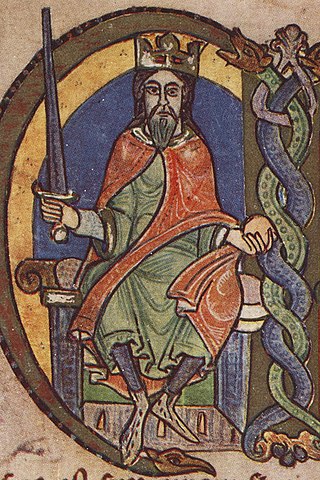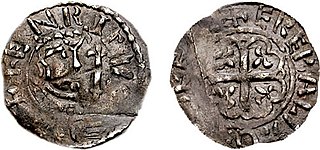Related Research Articles
Malcolm III was King of Scotland from 1058 to 1093. He was later nicknamed "Canmore". Malcolm's long reign of 35 years preceded the beginning of the Scoto-Norman age. Henry I of England and Eustace III of Boulogne were his sons-in-law, making him the maternal grandfather of Empress Matilda, William Adelin and Matilda of Boulogne. All three of them were prominent in English politics during the 12th century.

David I or Dauíd mac Maíl Choluim was a 12th-century ruler who was Prince of the Cumbrians from 1113 to 1124 and later King of Scotland from 1124 to 1153. The youngest son of Malcolm III and Margaret of Wessex, David spent most of his childhood in Scotland, but was exiled to England temporarily in 1093. Perhaps after 1100, he became a dependent at the court of King Henry I of England. There he was influenced by the Norman-French culture of the court.

Malcolm IV, nicknamed Virgo, "the Maiden" was King of Scotland from 1153 until his death. He was the eldest son of Henry, Earl of Huntingdon and Northumbria and Ada de Warenne. The original Malcolm Canmore, a name now associated with his great-grandfather Malcolm III, succeeded his grandfather David I, and shared David's Anglo-Norman tastes.
There are currently two earldoms of Mar in the Peerage of Scotland, and the title has been created seven times. The first creation of the earldom is currently held by Margaret of Mar, 31st Countess of Mar, who is also clan chief of Clan Mar. The seventh creation is currently held by James Erskine, 14th Earl of Mar and 16th Earl of Kellie, who is also clan chief of Clan Erskine.

Earl of Carrick is the title applied to the ruler of Carrick, subsequently part of the Peerage of Scotland. The position came to be strongly associated with the Scottish crown when Robert the Bruce, who had inherited it from his maternal kin, became King of the Scots in the early 14th century. Since the 15th century, the title of Earl of Carrick has automatically been held by the heir apparent to the throne, thus the current holder of the title is Prince William, Duke of Rothesay.

Donnchadh was a Gall-Gaidhil prince and Scottish magnate in what is now south-western Scotland, whose career stretched from the last quarter of the 12th century until his death in 1250. His father, Gille-Brighde of Galloway, and his uncle, Uhtred of Galloway, were the two rival sons of Fergus, Prince or Lord of Galloway. As a result of Gille-Brighde's conflict with Uhtred and the Scottish monarch William the Lion, Donnchadh became a hostage of King Henry II of England. He probably remained in England for almost a decade before returning north on the death of his father. Although denied succession to all the lands of Galloway, he was granted lordship over Carrick in the north.

Somerled, known in Middle Irish as Somairle, Somhairle, and Somhairlidh, and in Old Norse as Sumarliði, was a mid-12th-century Norse-Gaelic lord who, through marital alliance and military conquest, rose in prominence to create the Kingdom of Argyll and the Isles. Little is certain of Somerled's origins, although he may have been born in the north of Ireland and appears to have belonged to a Norse–Gaelic family of some prominence. His father, GilleBride, of royal Irish ancestry, appears to have conducted a marriage alliance with Máel Coluim mac Alaxandair, son of Alexander I of Scotland, and claimant to the Scottish throne. During a period of alliance with David I of Scotland, Somerled married Ragnhild, daughter of Óláfr Guðrøðarson, King of Man and the Isles in 1140. In 1153, Olaf of Man died and was succeeded by his son, Godred. But Godred Olafsson was a very unpopular ruler. Somerled was asked by Thorfinn Ottarson, a Manx chief, to allow Somerled's son, Dugall, to be appointed king of Man and the Isles. Somerled agreed and with 80 ships confronted Godred off the coast of Islay on January 5–6, 1156. After the sea battle, Somerled and Godred divided the Kingdom of Man and the Isles between them but Godred did not accept Dugall as King of Man. Accordingly, two years later, Somerled defeated and drove Godred from power. Dugall continued as King of Man and Somerled thus ruled the entire kingdom of Argyll, Man and the Isles until his death.
Morggán of Mar is the first Mormaer or Earl of Mar to appear in history as "more than a characterless name in a witness-list.". He is often known as Morgrund or Morgan. His father was Gille Chlerig.
Gille Críst of Mar is the fourth-known mormaer of Mar, from 1183 to 1203.
Donnchadh of Mar is the fifth known Mormaer of Mar, 1203–1244.

Fearchar of Ross or Ferchar mac in tSagairt, was the first of the Scottish Ó Beólláin family who received by Royal Grant the lands and Title of Mormaer or Earl of Ross (1223–1251) we know of from the thirteenth century, whose career brought Ross into the fold of the Scottish kings for the first time, and who is remembered as the founder of the Earldom of Ross.
Gospatric or Cospatric, , was Earl of Northumbria, or of Bernicia, and later lord of sizable estates around Dunbar. His male-line descendants held the Earldom of Dunbar, later known as the Earldom of March, in south-east Scotland until 1435, and the Lordship and Earldom of Home from 1473 until the present day.

Henry of Scotland was heir apparent to the Kingdom of Alba. He was also the 3rd Earl of Northumbria and the 3rd Earl of Huntingdon. He was the son of King David I of Scotland and Queen Maud, 2nd Countess of Huntingdon.

Alexander of Islay or Alexander MacDonald was a medieval Scottish nobleman who succeeded his father Domhnall of Islay as Lord of the Isles (1423–1449), later rising to the rank of Earl of Ross (1437–49). His lively career, especially before he attained the earldom of Ross, led Hugh MacDonald, the 17th century author of History of the MacDonalds, to commemorate him as "a man born to much trouble all his lifetime". Alexander allied himself with King James I of Scotland against the power of the Albany Stewarts in 1425 but, once the Albany Stewarts were out of the way, Alexander quickly found himself at odds with the new king. War with King James would initially prove Alexander's undoing, and would see the King's power in Scotland greatly increased, but at the Battle of Inverlochy Alexander's army prevailed against the forces of the King. Alexander died in 1449, having greatly extended his family's landed wealth and power. He was buried, not in the Isles of his ancestors, but at Fortrose Cathedral in his mainland Earldom of Ross.

Political and military events in Scotland during the reign of David I are the events which took place in Scotland during David I of Scotland's reign as King of Scots, from 1124 to 1153. When his brother Alexander I of Scotland died in 1124, David chose, with the backing of Henry I of England, to take the Kingdom of Alba for himself. David was forced to engage in warfare against his rival and nephew, Máel Coluim mac Alaxandair. Subduing the latter took David ten years, and involved the destruction of Óengus, mormaer of Moray. David's victory allowed him to expand his control over more distant regions theoretically part of the Kingdom. In this he was largely successful, although he failed to bring the Earldom of Orkney into his kingdom.
Ragnall mac Somairle was a significant late-twelfth-century magnate, seated on the western seaboard of Scotland. He was probably a younger son of Somairle mac Gilla Brigte, Lord of Argyll and his wife, Ragnhildr, daughter of Óláfr Guðrøðarson, King of the Isles. The twelfth-century Kingdom of the Isles, ruled by Ragnall's father and maternal grandfather, existed within a hybrid Norse-Gaelic milieu, which bordered an ever-strengthening and consolidating Kingdom of Scots.
Olvir Rosta, also known as Aulver Rosta, is a character within the mediaeval Orkneyinga saga, who is purported to have lived during the early 12th century. His Old Norse byname, rósta, means "brawl", "riot". His name, and byname, appear variously in English secondary sources.
Thomas of Galloway, known in Gaelic sources as Tomás Mac Uchtraigh, was a Gall-Gaidhil prince and adventurer. The son of Lochlann, king of Galloway, Thomas was an active agent of his brother Alan of Galloway as well as the English and Scottish kings. When King John, the English monarch, decided that central and western Ulster were to be added to his dominions, he conscripted Thomas and Alan of Galloway to his aid, offering them much of later counties Antrim, Londonderry and Tyrone as incentive.
Kermac Macmaghan was a thirteenth-century Scottish nobleman. In 1262, he is stated to have aided William I, Earl of Ross in a particularly vicious attack in the Hebrides. The assault itself is recorded by a thirteenth-century Scandinavian saga, and was likely conducted on behalf of Alexander III, King of Scotland, who wished to incorporate Isles into the Scottish realm. The following year, Hákon Hákonarson, King of Norway launched an expedition into the Isles to reassert Norwegian authority. The latter's campaign proved to be an utter failure, and after his departure and death the same year, the Scots forced the submission of the leading magnates of the Isles. In 1264, Kermac is recorded to have received compensation for services rendered. A fifteenth-century pedigree concerning Clan Matheson seems to indicate that Kermac is identical to a certain Coinneach mac Mathghamhna, ancestor of the clan. The latter may or may not be an ancestor of Clan Mackenzie.
The Galloway revolt of 1234–1235 was an uprising in Galloway during 1234–1235, led by Tomás mac Ailein and Gille Ruadh. The uprising was in response to the succession of Alan of Galloway, whereby King Alexander II of Scotland ordered Galloway to be divided the amongst Alan's three heiresses under Norman feudal law. This judgement excluded Alan's illegitimate son Tomás, who believed he was the rightful heir under the Gaelic system of tanistry. Alexander II responded by leading an army into Galloway to crush the rebellion. The Scottish army was almost routed, however was saved by the arrival of Fearchar, Earl of Ross and his forces. Walter Comyn, Lord of Badenoch was left to mop up the revolt, however was forced to abandon the region. Patrick II, Earl of Dunbar led another army in 1235, with Adam, Abbot of Melrose, and Gilbert, Bishop of Galloway and forced the submission of Tomás and Gille.
References
- Anderson, Early Sources, Vol. II, p. 494 in n.1 of 493
- Oram, "The Earls and Earldom of Mar", p. 47